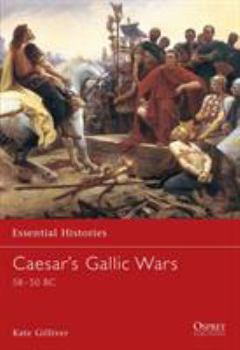Caesar's Gallic Wars: 58-50 BC
(Book #43 in the Osprey Essential Histories Series)
Select Format
Select Condition 
Book Overview
Julius Caesar was one of the most ambitious and successful politicians of the late Roman Republic and his short but bloody conquest of the Celtic tribes led to the establishment of the Roman province of Gaul (modern France). Caesar's commentaries on his Gallic Wars provide us with the most detailed surviving eye-witness account of a campaign from antiquity. Kate Gilliver makes use of this account and other surviving evidence to consider the importance of the Gallic Wars in the context of the collapse of the Roman Republic and its slide toward civil war.
Format:Paperback
Language:English
ISBN:1841763055
ISBN13:9781841763057
Release Date:November 2002
Publisher:Osprey Publishing (UK)
Length:96 Pages
Weight:0.75 lbs.
Dimensions:0.3" x 6.7" x 9.6"
Customer Reviews
3 ratings
Very good succinct account of Caesar's campaigns on this front
Published by Thriftbooks.com User , 15 years ago
This book provides a very good introduction to the topic in only 96 pages (about half of which are illustration) and can be read in about an hour and a half or two. First, like most Osprey series books in the series, it provides a few pages to provide some perspective into the region and the relationship between Rome and the peoples of Gaul (mostly one of border tensions and warfare). Then a few pages summarize the armies in terms of organization, weapons and other equipment, leadership, fighting strategies and strengths and weaknesses of each side. Although it is short it is quite good. Then there is a history of the campaign along with underlying analysis as to why Rome was able to eventually defeat the Gauls. Finally there are a few pages regarding the implications of this victory and Rome's attempts to convert the area into a Roman province. All and all an excellent introduction to the topic and an excellent primer for the hour and a half or two required to read it.
A good place to start
Published by Thriftbooks.com User , 22 years ago
I must confess that I don't know much about Ancient History. That is why I am really enjoying Osprey's Essential History series. This book is a better one in the series. It is well written and laid out (unlike The Punic Wars, which looked like it was assembled in a tornado). The colour maps and diagrams are placed close to the corresponding text.Of course it only skims the surface of Caesar's conquest of Gaul (modern day France), but that is all I want for now. It nicely sets up the next book in the series: Caesar's Civil War.
Excellent Concise Account
Published by Thriftbooks.com User , 22 years ago
Osprey's Essential History Volume 43, Caesar's Gallic Wars 58-50 BC, covers the series of wars in wars in Western Europe that made Julius Caesar a household name in ancient Rome. Kate Gilliver, a British academic who took in PhD in Roman military theory, uses Caesar's own commentaries as the basis for her synopsis, but tempers that biased account with input from other sources to provide greater balance. Indeed, military readers will be pleased with the sound use of military analysis in order to add value to this account; unlike many other historians who attempt to detail ancient campaigns, Gilliver remains focused on the primary elements of the conflict and does not become distracted with archaeological minutiae. The campaign maps provided in this volume also add greatly to the narrative, since most translations of Caesar's commentaries lack effective maps to demonstrate Roman operations. Overall, Gilliver's account should be pleasing to academics and military professionals, for shedding greater insight into how, why and what Caesar accomplished in Gaul. Caesar's Gallic Wars begins with a short introduction, a chronology, and a section on the background to the war. The section on the warring sides is 12 pages long and notes that, "the Gallic warriors fought as individuals, " but "the might of the Roman army lay in the strength of its formations, and that was based on unit morale, discipline and training." The heart of Gilliver's narrative - the sections on the outbreak of the war and the main campaigns of 58-50 BC, spans some 35 pages. The narrative is greatly aided by seven maps: the campaigns of 58 and 57 BC, the battle against the Helvetii in 58 BC, the battle against the Nervii in 57 BC, the campaigns of 56 and 55 BC, the campaigns of 54 and 53 BC, the campaigns of 52 and 51 BC, and the siege of Alesia. The final sections include portrait of a soldier (Caesar's centurions), the impact of the conflict (loss of life, slavery, destruction, food supplies, religious and social changes), portrait of a civilian (Roman merchants), how the war ended (Roman triumphs), and conclusions. The section of further reading is overly-brief, and considering the author's academic background, should have included pertinent journal articles from relevant historical and archaeological texts. Gilliver makes a number of interesting and often understated points about the military aspects of the Gallic Wars. First, the Romans had a technological edge in field artillery and siege warfare techniques that hurt the morale of Gallic opponents. In particular, the scorpion was a very effective anti-personnel weapon for which the Gauls had no equivalent. The Gaullic oppidum, or hill forts, had seemed resilient to attack in tribal warfare but they were easily reduced by efficient Roman siege methods. Second, the Gauls were accustomed to tribal warfare where rival armies disbanded during the winter months, but the professional Roman armies were capable






